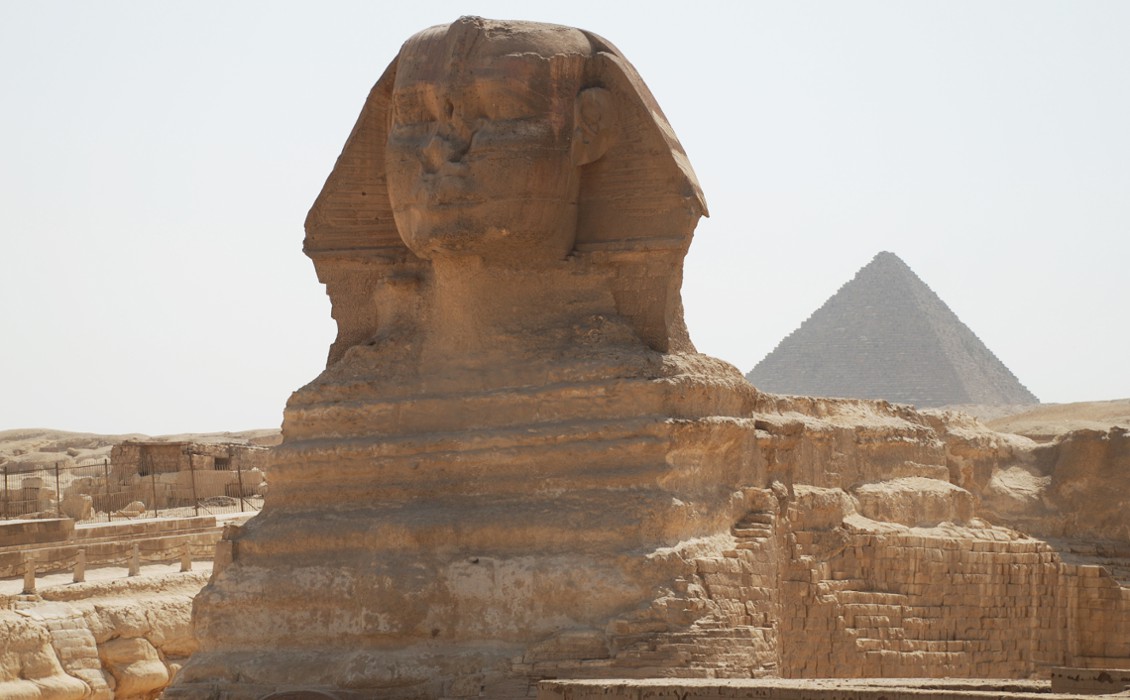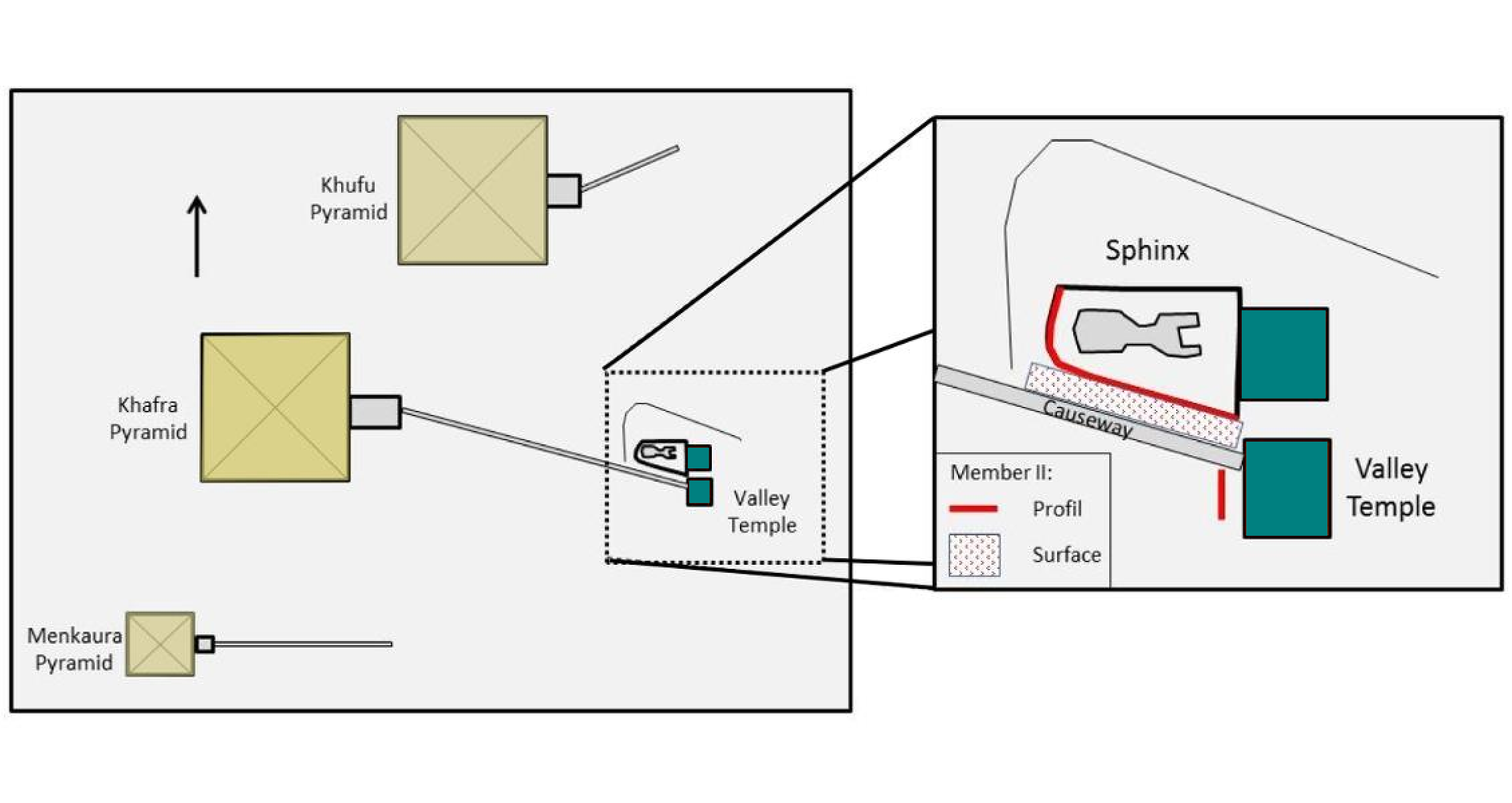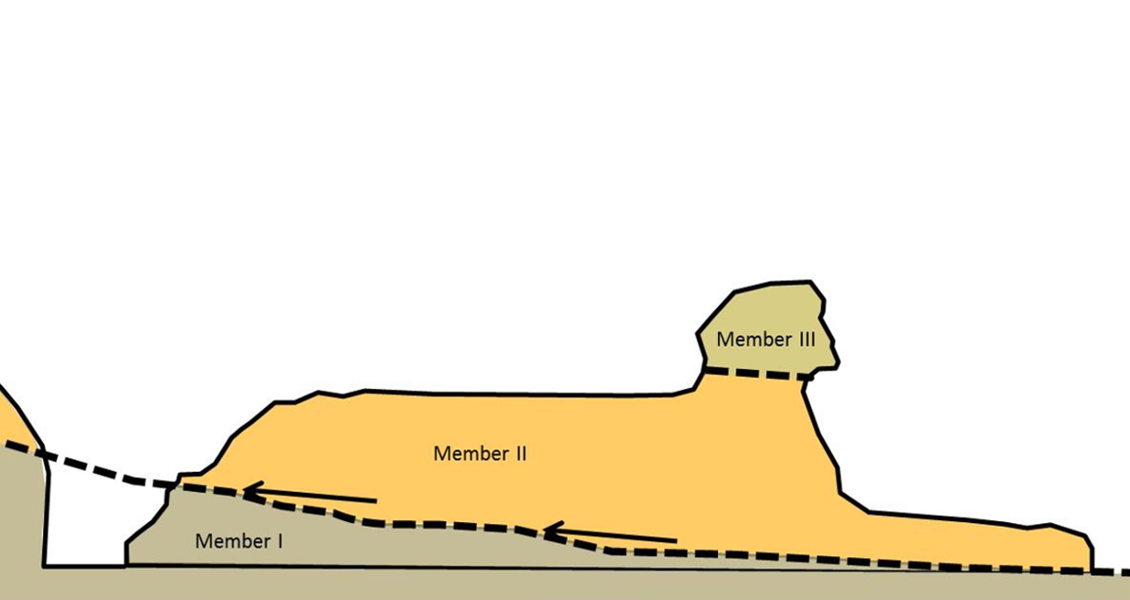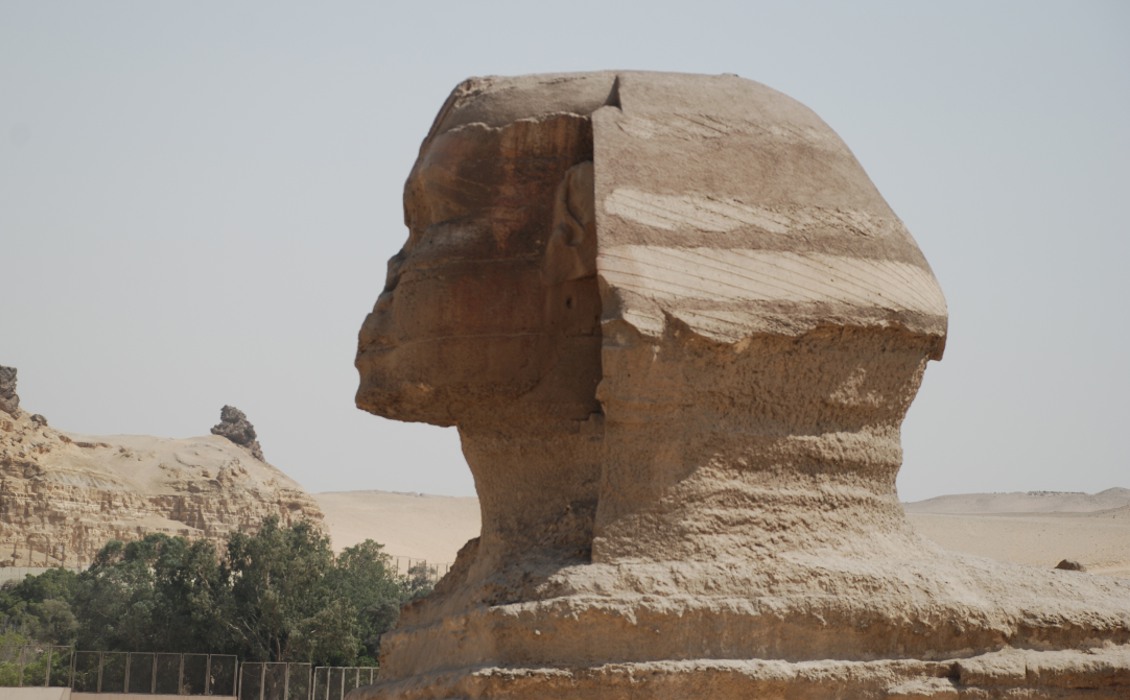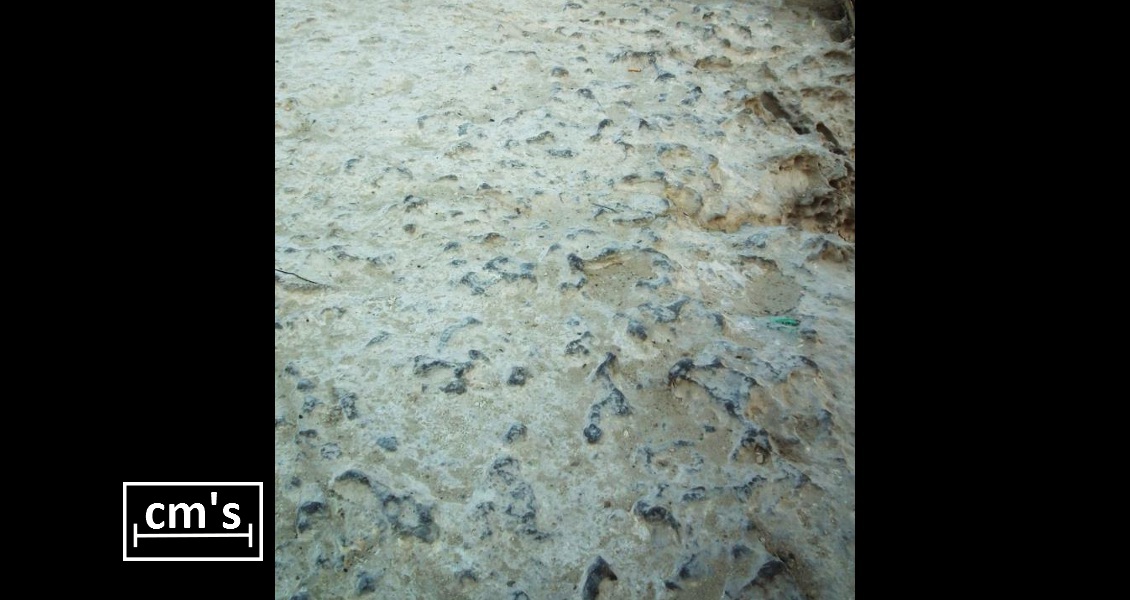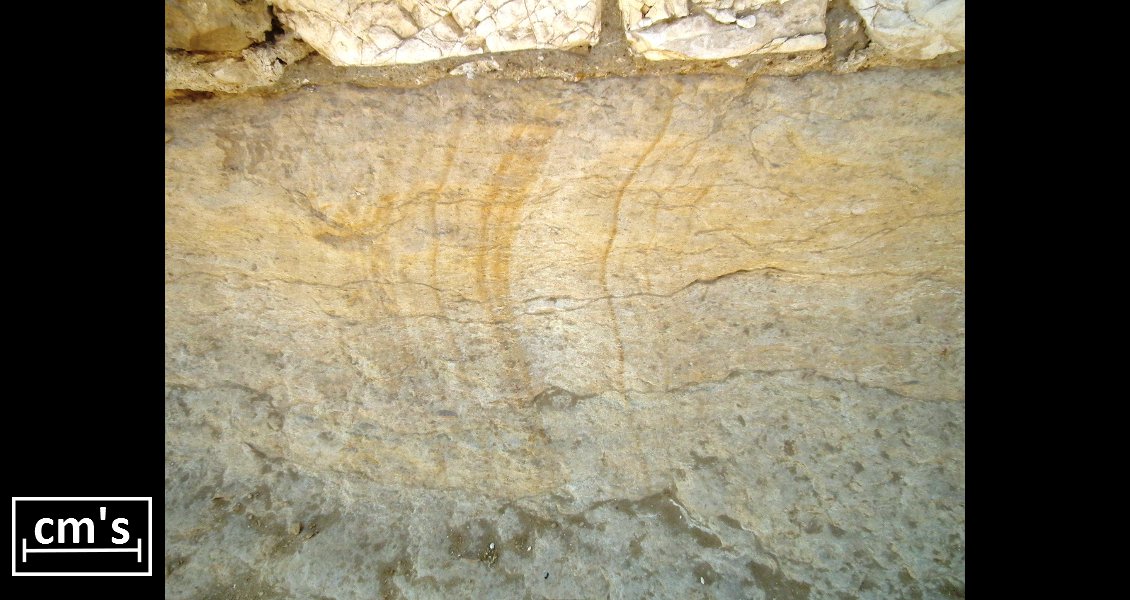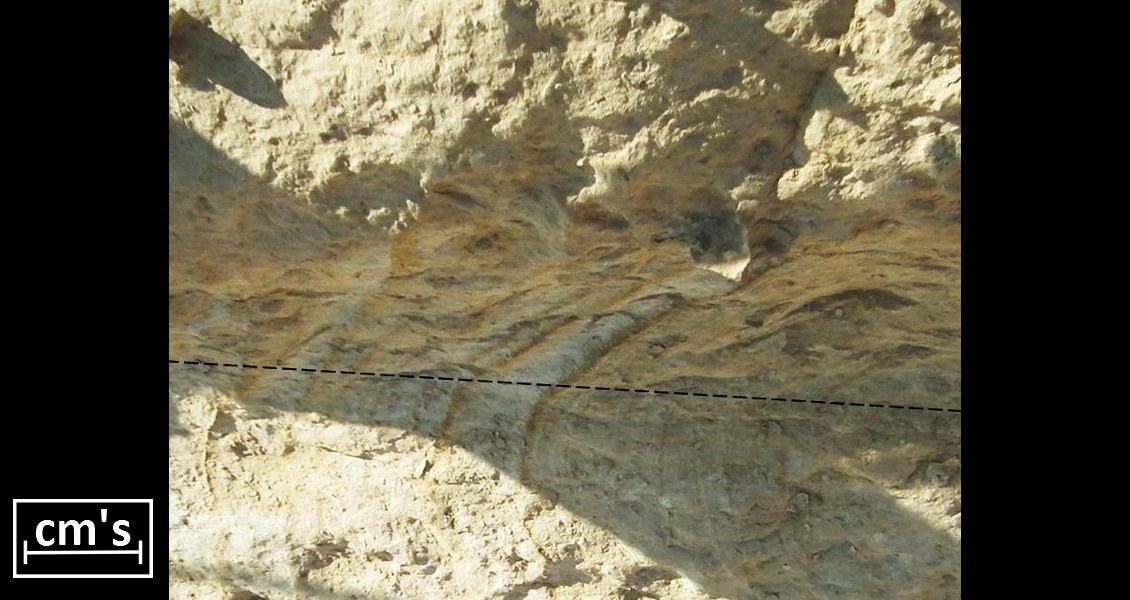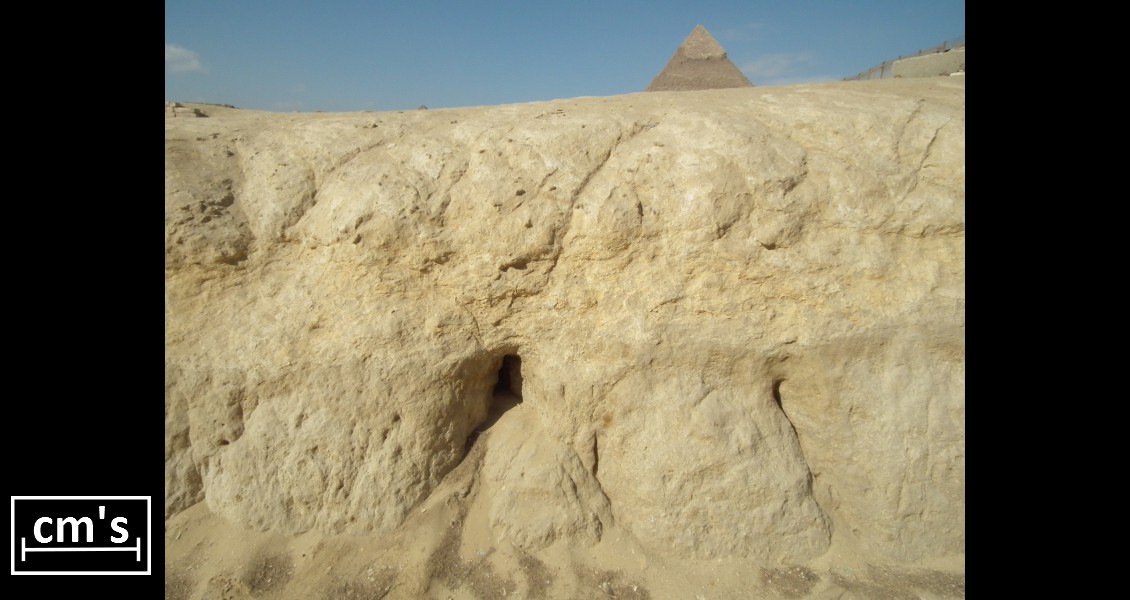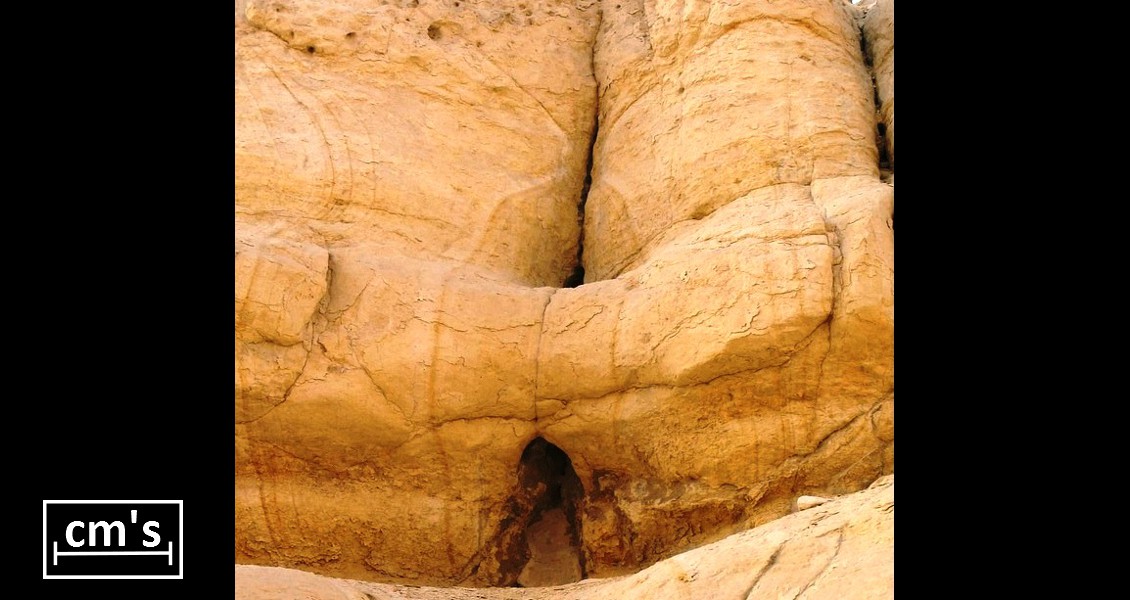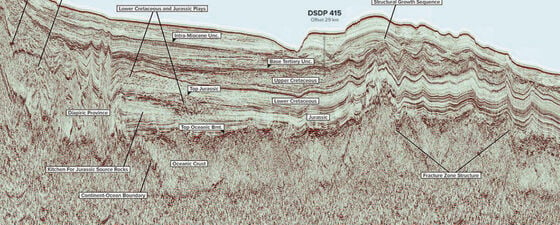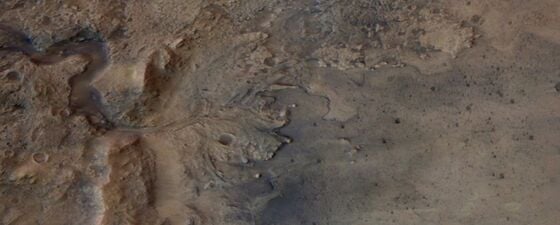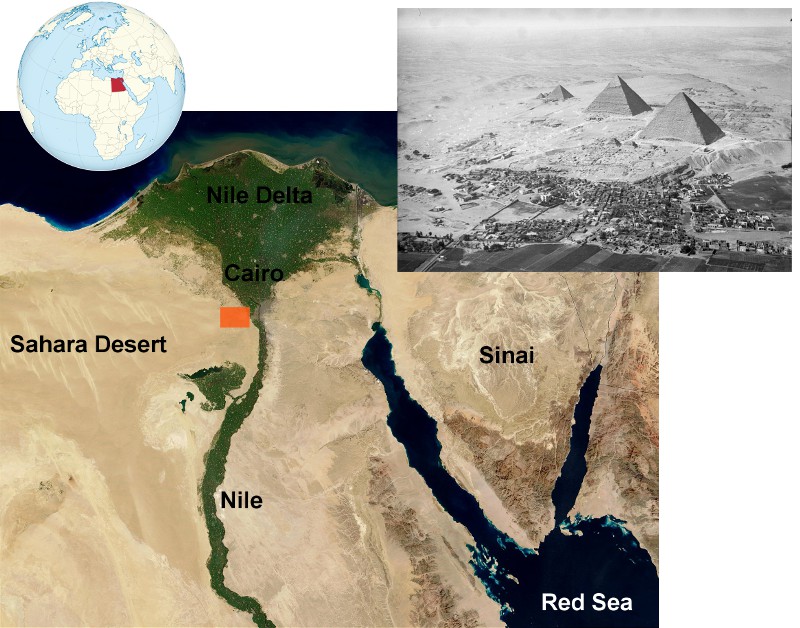 The Sphinx, a mythical creature with a lion’s body and a human head, stands on the Giza Plateau on the west bank of the Nile in Giza, Egypt, near the Great Pyramids (Orange box). The inset aerial photograph of the Great Pyramids at Giza is from James Henry Breasted, Jr. dated 1932. (Inset globe source: TUBS).At first glance the Great Sphinx and its surrounding enclosure walls at the Giza Plateau in Cairo appear to have been exposed to severe water erosion over a long period of time, in addition to the erosion caused by wind and sand. However, I recently visited the Sphinx enclosure to study the limestone rocks and came to a different conclusion; the rocks have clear signs of weathering and dissolution, much of it caused by rain water penetrating the fractured limestone long before the carving of the Sphinx. The role that water has played in erosion on the Sphinx itself is therefore ambiguous because its signature cannot be distinguished from the imprint from earlier weathering. Nature has played its own ‘shabby-chic trick’ to make the carved surfaces look older than they are, which has led even trained geologists to conclude that the Sphinx must have been carved while Egypt was still exposed to uninhibited seasonal rainfall and hence was several thousand years older than had been determined by archaeologists.
The Sphinx, a mythical creature with a lion’s body and a human head, stands on the Giza Plateau on the west bank of the Nile in Giza, Egypt, near the Great Pyramids (Orange box). The inset aerial photograph of the Great Pyramids at Giza is from James Henry Breasted, Jr. dated 1932. (Inset globe source: TUBS).At first glance the Great Sphinx and its surrounding enclosure walls at the Giza Plateau in Cairo appear to have been exposed to severe water erosion over a long period of time, in addition to the erosion caused by wind and sand. However, I recently visited the Sphinx enclosure to study the limestone rocks and came to a different conclusion; the rocks have clear signs of weathering and dissolution, much of it caused by rain water penetrating the fractured limestone long before the carving of the Sphinx. The role that water has played in erosion on the Sphinx itself is therefore ambiguous because its signature cannot be distinguished from the imprint from earlier weathering. Nature has played its own ‘shabby-chic trick’ to make the carved surfaces look older than they are, which has led even trained geologists to conclude that the Sphinx must have been carved while Egypt was still exposed to uninhibited seasonal rainfall and hence was several thousand years older than had been determined by archaeologists.
Most Egyptologists attribute the carving of the Great Sphinx to King Khafra of the Old Kingdom’s Fourth Dynasty, approximately 2,500 B.C. A pre-dynastic dating of the Sphinx resulting from the water erosion hypothesis was first suggested by author John A. West in his book Serpent in the Sky. This was followed up in 1992 in a paper by geologist Dr. Robert M. Schoch, Redating the Great Sphinx of Giza, which deals with scientific investigations of the weathering and erosion, and in which Schoch concluded that the vertical erosion was caused by water erosion after the carving of the Sphinx. This fueled a debate with Egyptologists that has continued for more than two decades. The earlier dating of the Sphinx has further inspired researchers and writers to link the Sphinx to ancient lost civilizations such as Atlantis.
In my investigation of the Sphinx and the surroundings I studied the rocks both inside the Sphinx enclosure walls and outside the fence surrounding the Sphinx and its enclosure walls. Only visual inspection was possible and no quantitative analysis of the rocks was made. However, the site offers excellent conditions for the inspection, analysis and interpretation of the limestone formations in three dimensions as the enclosure walls are carved at right angles to each other at a height of up to 10m. In addition, part of the Causeway immediately to the south of the Sphinx is exposed to bedrock offering a ‘map view’ for detailed understanding of the fracturing of the formation.
Depositional History
The limestone formations constituting the Sphinx and its surrounding enclosure are normally subdivided into three members, as shown in the profile below.
Member I: This member is well exposed in the western parts of the enclosure walls and floor and also forms the lower part of the Sphinx sculpture, (now covered with repair blocks). It is composed mostly of un-stratified dark gray limestone containing fossils and coral fragments, probably deposited in a shallow marine reef environment. After uplift the top of Member I was weathered and eroded, as can be seen in the topography and structure of the top of the layer. This resulted in secondary high porosity and the top formed an unconformity for later sedimentation, visible in the western part of the enclosure wall where Member II is lapping onto Member I. Refraction seismic acquired on the floor of the enclosure recorded notably higher interval velocities behind the Sphinx compared to the area in front of it. This conforms with the observation that the floor of the enclosure is carved well into the less weathered parts of Member I in the back of the Sphinx, while in the front the lower velocities, caused by the high porosity, were measured along or close to the top of the weathered unconformity of Member I.
Member II: This member constitutes the entire remaining enclosure walls and the body of the Sphinx up its neck. Member II is composed of stratified layers of very fine-grained light yellow/gray limestone some visible fossils, partly lapping on to Member I. It appears to have been deposited in a shallow marine, low energy, lagoonal environment, where the internal layering reflects variation of water depth, energy level and grain size during deposition.
Member III: This member is just represented by the head of the Sphinx. It appears to be a more homogeneous yellow/brown limestone in which layering is visible, but repair work using cement and the large distance to the head makes a detailed evaluation difficult. Since the head is small compared to the body, it has been suggested that it was re-sculpted at a much later date and hence appears less eroded. We can assume that this rock member was a topographical high just prior to carving of the Sphinx, but far back in time it was part of a uniform layer covering the entire Giza Plateau.
Further burial history of these members during early Tertiary time (~ 50-30 Ma) was not investigated, but a considerable additional sedimentary section must have been deposited on top of Member III on the Giza Plateau to account for the degree of lithification observed.
Uplift, Weathering, Erosion and Human Activity
Millions of years have passed since the sediments on top of Member III were deposited and later uplifted (probably starting in Oligocene/Miocene) and exposed to weathering and erosion by wind, sand and water. This history is largely unknown. The landscape we see today is a result of natural processes and extensive human activity from at least around 3,000 BC. One notable observation is that the sediments once deposited flat in a marine environment are now tilted gently to the south-east. Human activity has not only been limited to sculpturing the Sphinx and its enclosure; a considerable amount of rocks have been removed from the Giza Plateau while shaping the landscape and quarrying building material and blocks for construction of the other monuments surrounding the Sphinx. In addition, the area has experienced a significant influx of sand as it gradually changed from fertile land to desert after the last ice age. Occasionally the whole Sphinx enclosure was filled with sand in periods when people were not taking care of these magnificent monuments.
In addition, the traces of human activity are gradually erased by continued, rapid erosion processes. Unfortunately, the Sphinx and its enclosure are particularly exposed since the Member II turned out to be unfit to be used as a building material.
Analysis of Member II
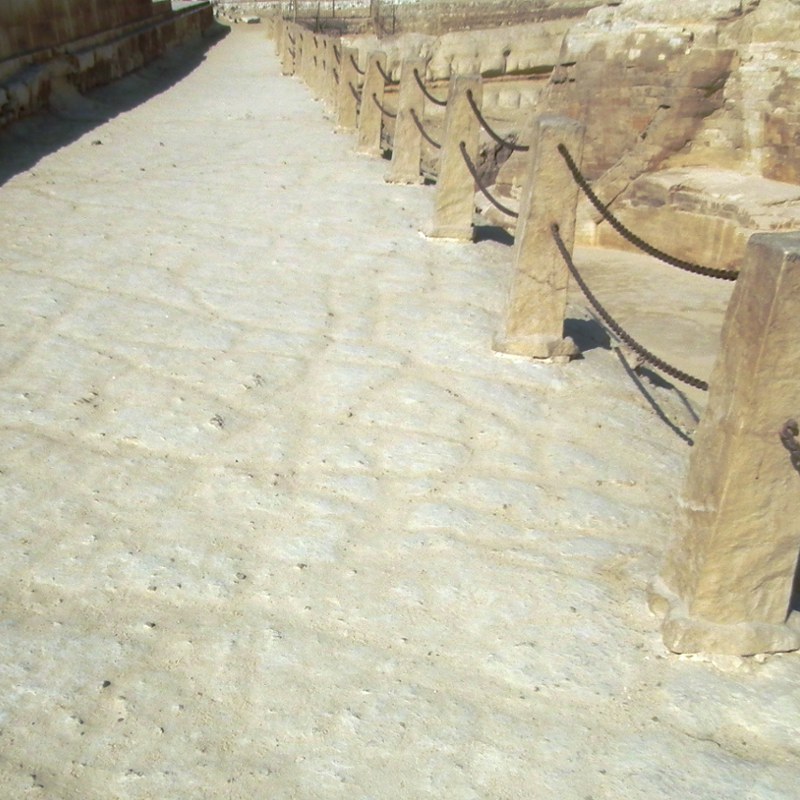 On the southern enclosure wall the local top of Member II today serves as a walkway for tourists. Its clean, nodular hard surface with a dense network of faults penetrating the formation is known as limestone pavement. The rounded shapes indicate it formed under a mantle of topsoil. (Source: Jørn Christiansen)Several factors contributed to the current poor rock quality of Member II, but they all have their origin in the composition of the fine grained muddy limestone matrix that hampered the initial lithification process.
On the southern enclosure wall the local top of Member II today serves as a walkway for tourists. Its clean, nodular hard surface with a dense network of faults penetrating the formation is known as limestone pavement. The rounded shapes indicate it formed under a mantle of topsoil. (Source: Jørn Christiansen)Several factors contributed to the current poor rock quality of Member II, but they all have their origin in the composition of the fine grained muddy limestone matrix that hampered the initial lithification process.
Fractures: The load of overburden on the water saturated mudstone and the resulting pressure and stress caused the Member II limestone to fail, forming a network of fractures. Visible chemical weathering of the rock around the fractures tells us that water has penetrated into the formation, as can be seen on the walls of the enclosure, and on the Causeway, where a network of fractures are visible on the surface, uninfluenced by the carving of the enclosure wall.
Limestone pavement: The Causeway immediately to the south of the Sphinx has a hard nodular crust developed on the top layer of the otherwise very fragile Member II. This nodular crust is a result of chemical weathering, when softer parts of the limestone were dissolved by acid rain through a mantle of topsoil. This surface shows remarkably few signs of wear from the millions of tourists who have walked on the Causeway to admire the Sphinx.
Water weathering: The fractures through Member II allowed acid rain water to penetrate the formation. Limestone is particularly susceptible to deterioration, principally through the effects of chemical dissolution. Even unpolluted rain contains carbon dioxide, creating a weak carbonic acid which is able to dissolve calcite, the main mineral component of the limestone. I found two pieces of evidence that shows that this chemical weathering of Member II started long before the carving of the Sphinx and its enclosure.
On the southern enclosure wall there are numerous exposures of colored, gently curved stripes, often several parallel similar to tree rings, crossing the stratigraphy. Some of these are slightly elevated compared to the surrounding, indicating a harder composition. The stripes are following the fractures and they are the visible evidence of a carbonic acid invasion zone resulting from rain water finding its way into the fractures from above. By the shape of the striping pattern I determined that they existed prior to the carving of the wall and is then the evidence that the chemical alteration took place before the excavation of the Sphinx and its enclosure.
The limestone on the Causeway represents a more resistive layer within Member II. However, the fractures remained open and allowed the rain water to find its way through this layer long before the carving of the enclosure walls. In several places under the harder Causeway layer we find both large and small cavities inside Member II where total dissolution of the limestone has taken place below vertical fractures. This is the evidence of the important role the vertical fractures played in the dissolution process of the cement.
We know that there was a lot more rain prior to carving the Sphinx than after, hence most of the damage to the formation along the fractures must have taken place before the Sphinx and its enclosure were created. The rock matrix has experienced variable degrees of dissolution of the cementation between the limestone grains, which resulted in later erosion along the fractures when they were exposed after the excavation of the enclosure. In addition the alteration of softer and harder layers in Member II has resulted in variable degree of horizontal erosion, all of which are nicely exposed in many photos of the Sphinx.
No Evidence
From a geological point of view I did not find any evidence that could date the carving of the Sphinx to a time earlier than any of the other monuments on the Giza plateau.
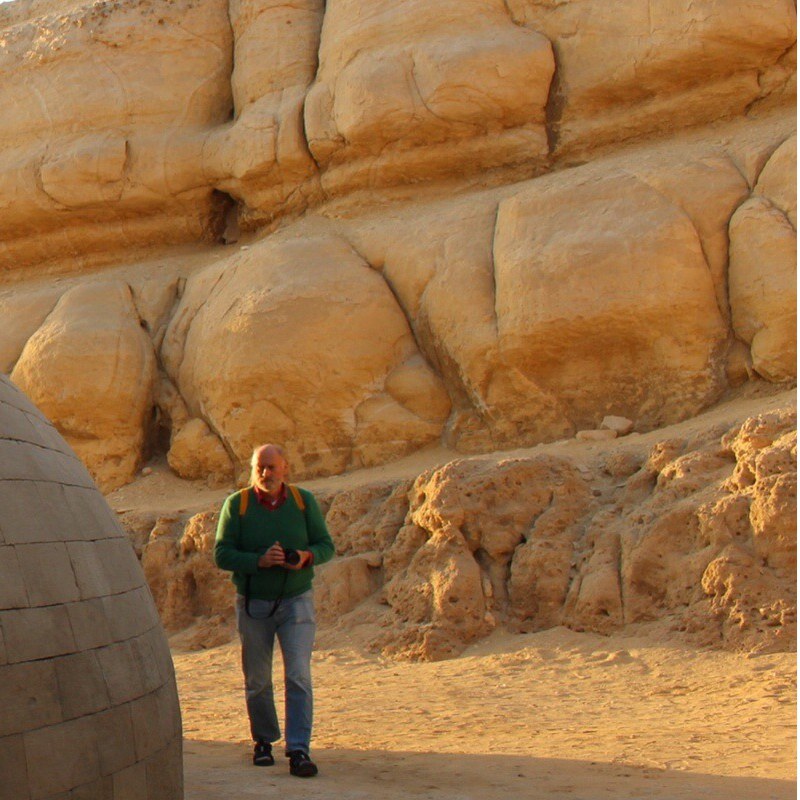 The author in front of the unconformity between Member I and Member II of the southern enclosure wall. Horizontal erosion occurs along the poorly consolidated units. Tracks of erosion along the chemically weathered fractures exposed on the wall are not vertical when fractures are oblique to the wall. (Source: Jørn Christiansen)It has been demonstrated how the Member II has gone through a chemical weathering process that generally follows the network of the fractures of the formation. Without being specific this alteration process has taken a long time, geologically speaking – long before human activity on the Giza Plateau began. Then, at some point in time the Sphinx and its enclosure was excavated and before long the wind, sand and occasional rain made the weaknesses on the edifice visible. Erosion took place horizontally along poorly cemented sub-units of Member II, and vertically where carbonic acid had been allowed to work along the fractures over geologic time. The latter is not unlike what would be expected from water erosion, but the alteration pattern and cavities in the rock proves that the weakness along the fractures of the formation existed prior to the carving of the Sphinx and its enclosure.
The author in front of the unconformity between Member I and Member II of the southern enclosure wall. Horizontal erosion occurs along the poorly consolidated units. Tracks of erosion along the chemically weathered fractures exposed on the wall are not vertical when fractures are oblique to the wall. (Source: Jørn Christiansen)It has been demonstrated how the Member II has gone through a chemical weathering process that generally follows the network of the fractures of the formation. Without being specific this alteration process has taken a long time, geologically speaking – long before human activity on the Giza Plateau began. Then, at some point in time the Sphinx and its enclosure was excavated and before long the wind, sand and occasional rain made the weaknesses on the edifice visible. Erosion took place horizontally along poorly cemented sub-units of Member II, and vertically where carbonic acid had been allowed to work along the fractures over geologic time. The latter is not unlike what would be expected from water erosion, but the alteration pattern and cavities in the rock proves that the weakness along the fractures of the formation existed prior to the carving of the Sphinx and its enclosure.
Likewise, the Valley and the Sphinx Temples, which were constructed with stones quarried from the Sphinx enclosure, were soon in ruins as a result of erosion and weathering. The Valley Temple was then ‘dressed’ in carefully custom-cut granite repair blocks from Aswan; incomprehensible precision work and a masterpiece of masonry, like so many other monuments in Egypt.
Considering the results of this analysis and interpretation of the rocks of the Sphinx monument and its surroundings, it is concluded that the amount of erosion observed and its expression cannot be used in estimating the age of the Sphinx. Superficial geological methods and probably also detailed petrophysical analysis are unsuited for dating the Sphinx with any precision since acid water had penetrated the formation and caused weathering long before its creation. The challenges to isolate and quantify the effect of the various parameters at work makes it simply too difficult to estimate the age.
However, what the rocks do tell us is that the southern enclosure wall, when carved, was perfectly aligned along the straight west-north-west to east-south-east running Causeway leading from the Valley Temple to the Khafra Pyramid, pointing 14° south of the eastwards looking Sphinx itself. That angle is no coincidence; it is the direction of the rising Sun on the 22 October, the day of the Hep Set Festival. So the Sphinx was carved as an integral part of a larger construction master plan on the Giza Plateau. In my mind geological and geophysical work done so far offers no help in answering the question as to when this plan was realized – this is still best estimated by the science of archaeology and astronomy.
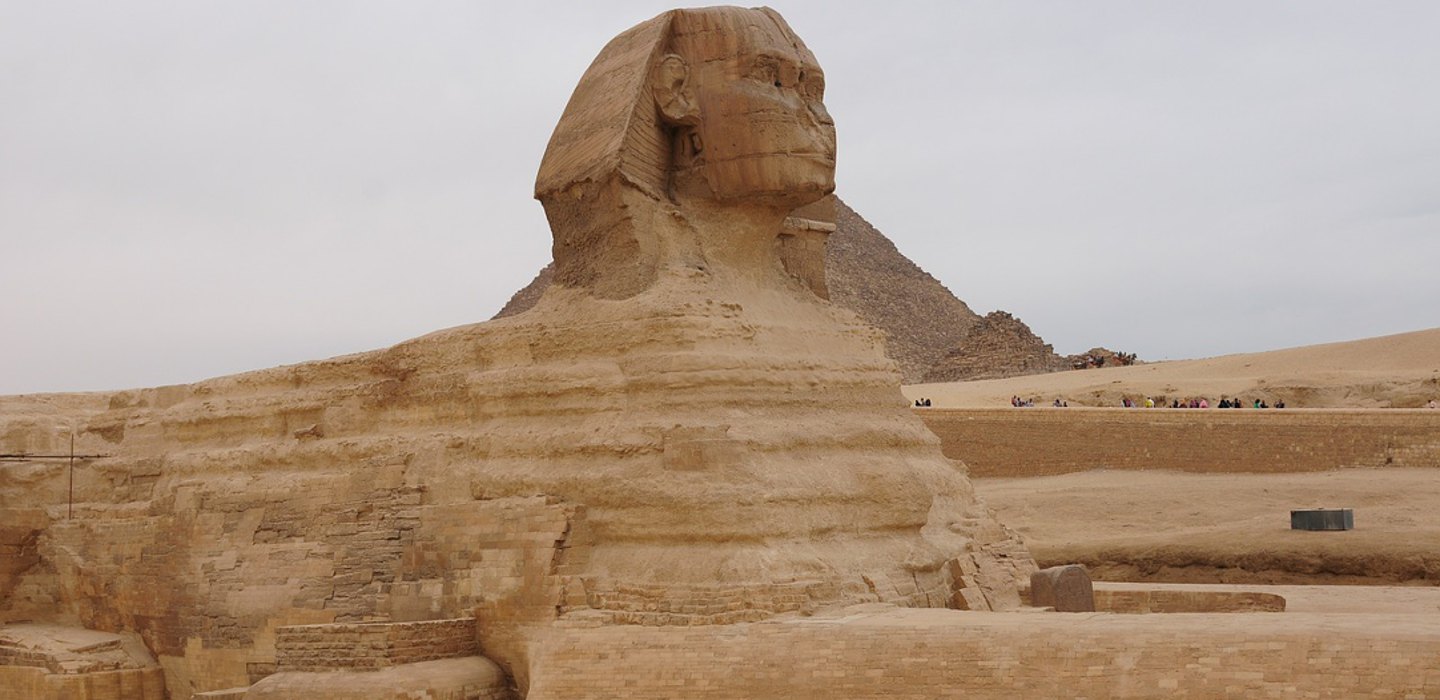 The Great Sphinx of Giza is a limestone statue of a reclining mythical animal, measuring 73.5 metres (241 ft) long, 19.3 metres (63 ft) wide, and 20.22 m (66.34 ft) high.
The Great Sphinx of Giza is a limestone statue of a reclining mythical animal, measuring 73.5 metres (241 ft) long, 19.3 metres (63 ft) wide, and 20.22 m (66.34 ft) high.


